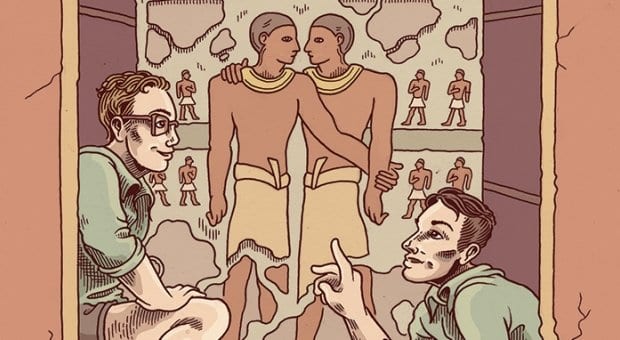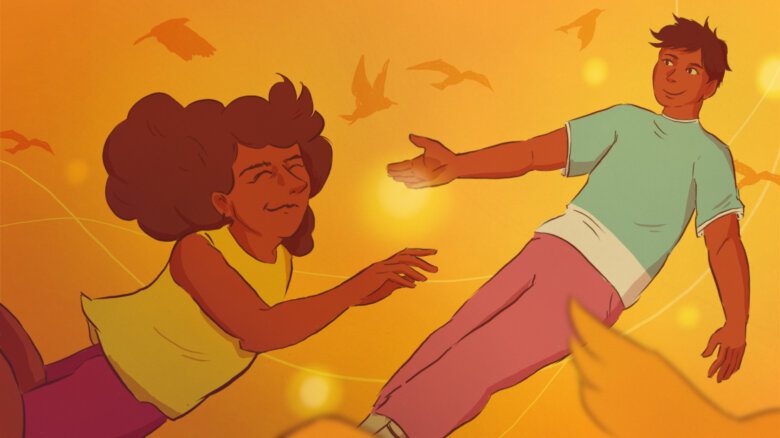Niankhkhnum and Khnumhotep were noblemen from the Fifth Dynasty of the Old Kingdom of Egypt who lived sometime in the 24th century BCE. The two men share a tomb in the pyramid of Unas, at Saqqara, a vast necropolis that served the ancient Egyptian capital of Memphis. Writing in the tomb identifies the duo as “Prophets of Ra in the Sun Temple of Nyuserre,” referring to the court of Pharaoh Nyuserre. More importantly, they were “Heads of the Manicurists of the Great House.”
When Mounir Basta, chief inspector of Lower Egypt, descended into the tomb in 1964, he found the images in the multichambered crypt intriguing and confusing: “Were they two brothers? Were they the father and son? Or were they two officials in the king’s palace who had enjoyed a cordial friendship in life and wished to keep it after death in the nether world?” In the years since Basta’s discovery, a number of studies have been published, some offering a theory that the two were brothers, maybe twins. The birth of twins would have been highly significant, given the potential dangers of such a birth for both the mother and children, and would explain why the men (unusually) worked together as head manicurists. Not being marked as brothers in their tomb is not unusual, since that would have required that they be placed in a family hierarchy, and the two are portrayed in the iconography as equals. Other evidence offered for the twin theory is that the wives and children of the two men are shown in a few scenes in the tomb… so if they have wives, they can’t have boyfriends, too?
According to a recent analysis of the iconography by Egyptologist Greg Reeder, this is where the sibling argument falls apart. While Niankhkhnum and Khnumhotep are depicted with their families in a couple of scenes, in one image, which shows the men at either end of a lavish banquet table, not only are their spouses not present, but the wife of Niankhkhnum, who had originally been carved into the scene, has been completely removed.
Entertainers in this banquet scene consist of a musical director facing his musicians, exclaiming, “Play the one about the two divine brothers,” which offers another clue: the song is likely about a myth in which the god Seth attempts to fuck another god, Horus, after a banquet. The story refers to rape, seduction or reciprocal sex, depending on where it’s told. Another Egyptologist has pointed out that in the story, Seth is motivated by desire for Horus, with the god even using “the earliest recorded chat-up line — ‘How lovely your backside is.’”
Adorning the room furthest inside the tomb are a series of intimate depictions of Niankhkhnum and Khnumhotep, with the two embracing and gazing at each other, often nose-to-nose. The men are surrounded by images of their children, though their wives aren’t present. Even more telling is that these images parallel traditional marital portraits found in other tombs. In depictions of opposite-sex partners, the wife is often “active,” meaning she has a hand on her husband’s shoulder or is grasping his waist or arm. Khnumhotep occupies the “active” role in every one of these intimate images.
The signs they left behind offer insight into how the royal manicurists wanted to be remembered. That they served together in a role usually performed by one person is exceptional, as are the marital depictions in their burial site. Khnum, one of the earliest Egyptian deities, was credited with creating humans using clay and a potter’s wheel. Both names invoke the creator god’s title, with Niankhkhnum roughly translating as “Khnum has life” and Khnumhotep as “Khnum is at peace.” Perhaps the two took on the names later in life to refer to their relationship. Their names, inscribed above a door in the tomb, may be a deliberate play on words and together read “Joined in life and joined in peace.”


 Why you can trust Xtra
Why you can trust Xtra


